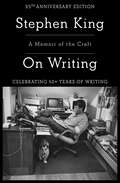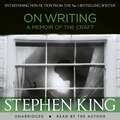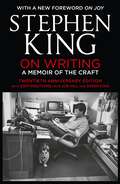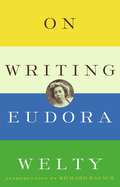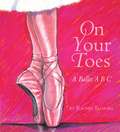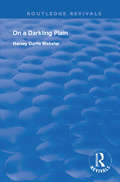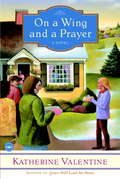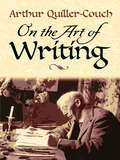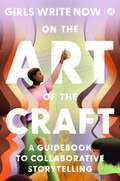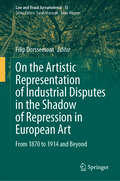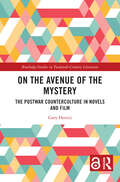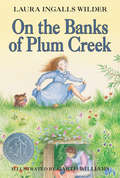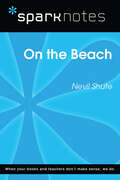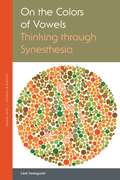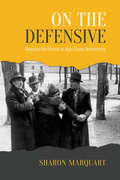- Table View
- List View
On Writing with Photography
by Karen Beckman Liliane WeissbergFrom James Agee to W. G. Sebald, there has been an explosion of modern documentary narratives and fiction combining text and photography in complex and fascinating ways. However, these contemporary experiments are part of a tradition that stretches back to the early years of photography. Writers have been integrating photographs into their work for as long as photographs have existed, producing rich, multilayered creations; and photographers have always made images that incorporate, respond to, or function as writing. On Writing with Photography explores what happens to texts—and images—when they are brought together.From the mid-nineteenth century to the present, this collection addresses a wide range of genres and media, including graphic novels, children&’s books, photo-essays, films, diaries, newspapers, and art installations. Examining the works of Herman Melville, Don DeLillo, Claude McKay, Man Ray, Dare Wright, Guy Debord, Zhang Ailing, and Roland Barthes, among others, the essays trace the relationship between photographs and &“reality&” and describe the imaginary worlds constructed by both, discussing how this production can turn into testimony of personal and collective history, memory and trauma, gender and sexuality, and ethnicity.Together, these essays help explain how writers and photographers—past and present—have served as powerful creative resources for each other.Contributors: Stuart Burrows, Brown U; Roderick Coover, Temple U; Adrian Daub, Stanford U; Marcy J. Dinius, DePaul U; Marianne Hirsch, Columbia U; Daniel H. Magilow, U of Tennessee, Knoxville; Janine Mileaf; Tyrus Miller, U of California, Santa Cruz; Leah Rosenberg, U of Florida; Xiaojue Wang, U of Pennsylvania.
On Writing: A Memoir Of The Craft
by Stephen KingCELEBRATING 50 YEARS OF WRITING with fresh testimonials from fellow writers about why they love Stephen King and On Writing—and a few new words on the joy of writing from King himself. *ONE OF TIME MAGAZINE&’S TOP 100 NONFICTION BOOKS OF ALL TIME* Immensely helpful and illuminating to any aspiring writer, this special edition of Stephen King&’s critically lauded, million-copy bestseller shares the experiences, habits, and convictions that have shaped him and his work. &“Long live the King&” hailed Entertainment Weekly upon publication of Stephen King&’s On Writing. Part memoir, part master class by one of the bestselling authors of all time, this superb volume is a revealing and practical view of the writer&’s craft, comprising the basic tools of the trade every writer must have. King&’s advice is grounded in his vivid memories from childhood through his emergence as a writer, from his struggling early career to his widely reported, near-fatal accident in 1999—and how the inextricable link between writing and living spurred his recovery. Brilliantly structured, friendly and inspiring, On Writing will empower and entertain everyone who reads it—fans, writers, and anyone who loves a great story well told.
On Writing: A Memoir of the Craft
by Stephen KingNot since Dickens has a writer had so many readers by the throat . . . King's imagination is vast. He knows how to engage the deepest sympathies of his readers . . . It is part biography, part collection of tips for the aspiring writer. In the final chapters, King tells, in graphic details, the story of his recent accident . . . a bizarre and absorbing story, told brillinatly by one of the great storytellers of our time' - GuardianIn June of 1999, Stephen King was hit by a van while walking along the shoulder of a country road in Maine. Six operations were required to save his life and mend his broken body. When he was finally able to sit up, he immediately started writing. This book is the extraordinary result.(P)2000 Simon & Schuster Audio Division, Simon & Schuster Inc.
On Writing: A Memoir of the Craft
by Stephen KingThere is a reason why Stephen King is one of the bestselling writers in the world, ever. Described in the Guardian as 'the most remarkable storyteller in modern American literature', Stephen King writes books that draw you in and are impossible to put down.Part memoir, part master class by one of the bestselling authors of all time, this superb volume is a revealing and practical view of the writer's craft, comprising the basic tools of the trade every writer must have. King's advice is grounded in the vivid memories from childhood through his emergence as a writer, from his struggling early career to his widely reported, near-fatal accident in 1999 - and how the inextricable link between writing and living spurred his recovery.
On Writing: Women Writing On Photography From The 1850s To The Present
by Eudora WeltyEudora Welty was one of the twentieth century's greatest literary figures. For as long as students have been studying her fiction as literature, writers have been looking to her to answer the profound questions of what makes a story good, a novel successful, a writer an artist. On Writing presents the answers in seven concise chapters discussing the subjects most important to the narrative craft, and which every fiction writer should know, such as place, voice, memory, and language. But even more important is what Welty calls "the mystery" of fiction writing--how the writer assembles language and ideas to create a work of art.Originally part of her larger work The Eye of the Story but never before published in a stand-alone volume, On Writing is a handbook every fiction writer, whether novice or master, should keep within arm's reach. Like The Elements of Style, On Writing is concise and fundamental, authoritative and timeless--as was Eudora Welty herself.From the Hardcover edition.
On Your Toes: A Ballet ABC
by Rachel IsadoraA former professional ballerina and Caldecott Honor artist presents this ABC book that gives young readers an inside look at the ballet while explaining terms and positions using the alphabet.
On a Darkling Plain (Routledge Revivals)
by Harvey Curtis WebsterOriginally published in 1947 and presenting the famed poet-novelist against the background of contemporary thought and society, Harvey Curtis Webster shows that Hardy's later works give consistent evidence of hope; that pervasive pessimism was by no means the keynote of Hardy's thought. On a Darkling Plain traces the evolution of Hardy's thought, from faith, through disillusionment, to a cautious belief in the ultimate progress of man.
On a Wing and a Prayer
by Katherine ValentineThe New England town of Dorsetville, "where miracles are never far away," faces unexpected challenges in this much-anticipated fourth volume of Katherine Valentine's beloved series. The rumor mill is running at full speed: the Country Kettle Café, meeting place for everyone who's anyone, may close down now that the owner's wife has struck it rich. Deputy Hill is devastated over his open-ended assignment to the graveyard shift, his just desserts for having nearly wrecked a car and a wedding in one unfortunate mishap. Then tragedy strikes: the Gallagher twins are fighting for their lives after a fall through the ice--one on life support and the other in a coma. Doc Hammond is waging his own battle for life while helping the twins. More than ever, Dorsetville needs a miracle.
On an Irish Island: The Lost World Of The Great Blasket
by Robert KanigelOn an Irish Island is a love letter to a vanished way of life, in which Robert Kanigel, the highly praised author of The Man Who Knew Infinity and The One Best Way, tells the story of the Great Blasket, a wildly beautiful island off the west coast of Ireland, renowned during the early twentieth century for the rich communal life of its residents and the unadulterated Irish they spoke. With the Irish language vanishing all through the rest of Ireland, the Great Blasket became a magnet for scholars and writers drawn there during the Gaelic renaissance--and the scene for a memorable clash of cultures between modern life and an older, sometimes sweeter world slipping away. Kanigel introduces us to the playwright John Millington Synge, some of whose characters in The Playboy of the Western World, were inspired by his time on the island; Carl Marstrander, a Norwegian linguist who gave his place on Norway's Olympic team for a summer on the Blasket; Marie-Louise Sjoestedt, a Celtic studies scholar fresh from the Sorbonne; and central to the story, George Thomson, a British classicist whose involvement with the island and its people we follow from his first visit as a twenty-year-old to the end of his life. On the island, they met a colorful coterie of men and women with whom they formed lifelong and life-changing friendships. There's Tomás O'Crohan, a stoic fisherman, one of the few islanders who could read and write Irish, who tutored many of the incomers in the language's formidable intricacies and became the Blasket's first published writer; Maurice O'Sullivan, a good-natured prankster and teller of stories, whose memoir, Twenty Years A-Growing, became an Irish classic; and Peig Sayers, whose endless repertoire of earthy tales left listeners spellbound. As we get to know these men and women, we become immersed in the vivid culture of the islanders, their hard lives of fishing and farming matched by their love of singing, dancing, and talk. Yet, sadly, we watch them leave the island, the village becoming uninhabited by 1953. The story of the Great Blasket is one of struggle--between the call of modernity and the tug of Ireland's ancient ways, between the promise of emigration and the peculiar warmth of island life amid its physical isolation. But ultimately it is a tribute to the strength and beauty of a people who, tucked away from the rest of civilization, kept alive a nation's past, and to the newcomers and islanders alike who brought the island's remarkable story to the larger world.
On the Art of Writing
by Arthur Quiller-Couch"The art of writing is a living business," declares Sir Arthur Quiller-Couch in the Preface to this classic. "Literature is not a mere science, to be studied; but an art, to be practiced. Great as is our own literature, we must consider it as a legacy to be improved . . . if we persist in striving to write well, we can easily resign to other nations all the secondary fame."Renowned as a critic, teacher, and educational reformer, Quiller-Couch delivered a series of lectures at the University of Cambridge in 1913-14. His subjects--the artistic and vital nature of language as well as the skills needed to convey and receive the written word--remain as timeless as his advice. This book contains the eminent scholar's remarks from those lectures on the practice of writing, the difference between verse and prose, the use of jargon, the history of English literature, the ways in which English literature is taught at the university, and the importance of style. The principles and practical guidelines he sets forth in this volume offer aspiring writers an enduring source of guidance.
On the Art of the Craft: A Guidebook to Collaborative Storytelling
by Girls Write NowA writing companion, inspirational guide to the craft, and anthology featuring interactive multi-genre work from the acclaimed organization on its twenty-fifth anniversary.We all have stories to tell, but not everyone gets the mentoring and training or encouragement to become a great storyteller. Founded a quarter century ago, Girls Write Now has empowered young women and gender-expansive youth to harness their creative talents, gaining confidence, skills, and a community supporting them in sharing stories the world needs to hear.This hands-on guide—conceived of and written and edited by the young people of Girls Write Now—draws from the organization’s dynamic curriculum and the writers’ own personal experiences spanning decades. It offers aspiring writers the tools they need to develop their craft—including tips, insight, and advice on the writing and publishing process as well as critical thinking about the future of storytelling.With this handbook, readers everywhere can equip themselves to shape their life stories, and become the writers and leaders they dream of being.
On the Artistic Representation of Industrial Disputes in the Shadow of Repression in European Art: From 1870 to 1914 and Beyond (Law and Visual Jurisprudence #15)
by Filip DorssemontThis book is the first volume on the artistic representation of industrial disputes in European art (from 1870 to 1914) since the catalogue of the landmark exhibition Streik, Realität und Mythos, organized by the Deutsches Historisches Museum (1992). It has been written by a group of scholars who share a keen interest in social history and the history of art, as well as in-depth knowledge of industrial relations and collective labour law. Seeking to transcend a purely western European perspective, the book offers unprecedented insights into artistic production in Poland and Hungary from the 19th century to the communist era. It even goes beyond the European continent, examining the United States and Mexico. The media explored include painting, sculpture, the graphic arts and photography. Further, the book deals with artists great (Carlo Carrà, Walter Crane, James Ensor, Juan Gris, Käthe Kollwitz, Constantin Meunier,Mihály Munkácsy, Théophile-Alexandre Steinlen and Jan Toorop) and small, sometimes even anonymous. The artistic styles range from (social) realism, naturalism and neo-impressionism to futurism and socialist realism. All stages of industrial disputes (from the causes of strikes to their violent suppression) are subjected to iconographical and iconological analysis, combined with perspectives from visual studies, critical art and gender studies. Agricultural workers, miners, construction workers and textile workers fill the scenes. Most of them are subordinate workers; others are (bogus) independent workers and migrant workers. Given its scope, the book will be of interest to (art) historians, labour law scholars, and specialists in industrial relations.
On the Avenue of the Mystery: The Postwar Counterculture in Novels and Film (Routledge Studies in Twentieth-Century Literature)
by Gary HentziThis volume is a study of eight major novels from the postwar period (1945-65) in conjunction with the films made from them during a later period of a little less than three decades straddling the millennium (1985-2012). The comparison of these novels (by Ken Kesey, Paul Bowles, Carson McCullers, Jack Kerouac, James Baldwin, Alexander Trocchi, William Burroughs, and Peter Matthiessen) with their film adaptations offers the opportunity for a historical reassessment not only of the novels themselves but also of the global counterculture of the years 1965-75, which they prefigure in a variety of ways. Appearing more than a decade after the waning of the counterculture and in some cases as much as fifty years after the novels on which they are based, the films display significant revisions and omissions prompted by the historical and cultural changes of the intervening years. Whereas these changes are nowadays often interpreted in purely political terms, this book argues that the religious theme of mystery and its decline is central to the novels and films and is a key feature of the period of cultural transformation that they bookend. At once a work of literary criticism, film studies, and cultural history, this text has the potential to reach both an academic audience and the broader readership that has long existed for these novels as well as the even broader one interested in reappraising the period of the global counterculture—among the most important of the influences that have shaped the contemporary world.
On the Avenue of the Mystery: The Postwar Counterculture in Novels and Film (Routledge Studies in Twentieth-Century Literature)
by Gary HentziThis volume is a study of eight major novels from the postwar period (1945–65) in conjunction with the films made from them during a later period of a little less than three decades straddling the millennium (1985–2012). The comparison of these novels (by Ken Kesey, Paul Bowles, Carson McCullers, Jack Kerouac, James Baldwin, Alexander Trocchi, William Burroughs, and Peter Matthiessen) with their film adaptations offers the opportunity for a historical reassessment not only of the novelsthemselves but also of the global counterculture of the years 1965–75, which they prefigure in a variety of ways. Appearing more than a decade after the waning of the counterculture and in some cases as much as fifty years after the novels on which they are based, the films display significant revisions and omissions prompted by the historical and cultural changes of the intervening years. Whereas these changes are nowadays often interpreted in purely political terms, this book argues that the experience of mystery and its decline is central to the novels and films and is a key feature of the period of cultural transformation that they bookend. At once a work of literary criticism, film studies, and cultural history, this book has the potential to reach both an academic audience and the broader readership that has long existed for these novels as well as the even broader one interested in reappraising the period of the global counterculture—among the most important of the influences that have shaped the contemporary world.The Open Access version of this book, available at http://www.taylorfrancis.com, has been made available under a Creative Commons Attribution-Non Commercial-No Derivatives (CC BY-NC-ND) 4.0 license.
On the Banks of Plum Creek
by Laura Ingalls Wilder Garth WilliamsThe fourth book in Laura Ingalls Wilder's treasured Little House series, and the recipient of a Newbery Honor--now available as an ebook! This digital version features Garth Williams's classic illustrations, which appear in vibrant full color on a full-color device and in rich black-and-white on all other devices.The adventures of Laura Ingalls and her family continue as they leave the prairie and travel in their covered wagon to Walnut Grove, Minnesota. Here they settle in a new home made of sod beside the banks of Plum Creek. Soon Pa builds a wonderful new little house with real glass windows and a hinged door. Laura and her sister Mary go to school, help with the chores, and fish in the creek. At night everyone listens to the merry music of Pa's fiddle. Misfortunes come in the form of a grasshopper plague and a terrible blizzard, but the pioneer family works hard together to overcome these challenges.The nine Little House books are inspired by Laura's own childhood and have been cherished by generations of readers as both a unique glimpse into America's frontier history and as heartwarming, unforgettable stories.Correlates to the Common Core State Standards in English Language Arts
On the Beach (SparkNotes Literature Guide Series)
by SparkNotesOn the Beach (SparkNotes Literature Guide) by Nevil Shute Making the reading experience fun! Created by Harvard students for students everywhere, SparkNotes is a new breed of study guide: smarter, better, faster. Geared to what today's students need to know, SparkNotes provides: *Chapter-by-chapter analysis *Explanations of key themes, motifs, and symbols *A review quiz and essay topicsLively and accessible, these guides are perfect for late-night studying and writing papers
On the Bright Side
by Abeka BooksOn the Bright Side delights readers with amusing and thought-provoking selections and challenges them to think deeper by highlighting the terms fiction and nonfiction and reviewing all literary concepts taught in third grade.
On the Bullet Train with Emily Brontë: Wuthering Heights in Japan
by Judith PascoeWhile teaching in Japan, Judith Pascoe was fascinated to discover the popularity that Emily Brontë’s novel Wuthering Heights has enjoyed there. Nearly 100 years after its first formal introduction to the country, the novel continues to engage the imaginations of Japanese novelists, filmmakers, manga artists and others, resulting in numerous translations, adaptations, and dramatizations. On the Bullet Train with Emily Brontë is Pascoe’s lively account of her quest to discover the reasons for the continuous Japanese embrace of Wuthering Heights, including quite varied and surprising adaptations of the novel. At the same time, the book chronicles Pascoe’s experience as an adult student of Japanese. She contemplates the multiple Japanese translations of Brontë, as contrasted to the single (or non-existent) English translations of major Japanese writers. Carrying out a close reading of a distant country’s Wuthering Heights, Pascoe begins to see American literary culture as a small island on which readers are isolated from foreign literature. In this and in her previous book, The Sarah Siddons Audio Files, Pascoe’s engaging narrative innovates a new scholarly form involving immersive research practice to attempt a cross-cultural version of reader-response criticism. On the Bullet Train with Emily Brontë will appeal to scholars in the fields of 19th-century British literature, adaptation studies, and Japanese literary history.
On the Causes of the Greatness and Magnificence of Cities
by Geoffrey SymcoxThe first treatise ever written on the sociology of cities, On the Causes of the Greatness and Magnificence of Cities (1588) marked a radical departure from previous literature on urban centres. It provided a revolutionary analysis of how cities function, and of the political, economic, demographic and geographic factors that cause their growth and decline. Noteworthy too is Botero's strikingly original use of sources in his analysis: moving beyond familiar classical and biblical references, he drew groundbreaking insights from reports by travelers and missionaries about cities in the non-European world, especially in China.Though seminally important to the history of urban studies, On the Causes of the Greatness and Magnificence of Cities has not been available in a modern translation until now. This edition of the treatise - which includes an introduction by Geoffrey W. Symcox on the intellectual context within which it was conceived - is a must-read for anyone interested in the life of cities both historical and contemporary.
On the Colors of Vowels: Thinking through Synesthesia (Verbal Arts: Studies in Poetics)
by Liesl YamaguchiTreatments of synesthesia in the arts and humanities generally assume a clear distinction between the neurological condition and the literary device. Synesthetes’ descriptions of colors seen in connection with music, for example, are thought to differ fundamentally from common expressions that rely on transpositions across sensory dimensions (“bright vowels”). This has not always been the case. The distinction emerged over the course of the twentieth century, as scientists sought to constitute “synesthesia” as a legitimate object of modern science.On the Colors of Vowels investigates the ambiguity of visual descriptions of vowels across a wide range of disciplines, casting several landmark texts in a wholly new light. The book traces the migration of sound-color correspondence from its ancient host (music) to its modern one (vowels), investigating the vocalic Klangfarben of Hermann von Helmholtz’s monumental Sensations of Tone, the vowel colors reported in early psychology surveys into audition colorée (colored hearing), the mis-matched timbres that form poetry’s condition of possibility in Stéphane Mallarmé’s “Crisis of Verse,” and the vowel-color analogy central to both the universal alphabets of the nineteenth century and the phonological universals of the twentieth. The book’s final chapter turns to an intricately detailed account of vowel-color correspondence by Ferdinand de Saussure, suggesting how the linguist’s sensitivity to vowel coloration may have guided his groundbreaking study of Indo-European vocalism.Bringing out the diverse ways in which visual conceptions of vowels have inflected the arts and sciences of modernity, On the Colors of Vowels makes it possible to see how discourses of the nineteenth and twentieth centuries crafted the enigma we now readily recognize as “synesthesia.”
On the Comic and Laughter
by Paul J. Perron Vladimir Propp Jean-Patrick DebbècheAn extensive investigation of the forms and functions of the comic, this lively and engaging English critical edition will be welcomed by those interested in laughter, comedy, folklore, Russian literature, and specific authors such as Gogol, Pushkin, Chekhov, Rabelais, Molière, and Shakespeare. The direct, humorous, and provocative style of this work, which tackles the subject of humour with a vast array of vivid examples encountered on every page, will certainly appeal to the contemporary reader. Vladimir Propp takes various forms of laughter in literature and real life and addresses questions such as the comic of similarity, the comic of difference, parody, duping, incongruity, lying, ritual laughter, and carnival laughter. The author of the widely acclaimed Morphology of the Folktale has written an original, comprehensive, and exciting study on how humour works, and on everything you wanted to know about the genre, in a clear, approachable, and insightful manner.
On the Commerce of Thinking: Of Books and Bookstores
by Jean-Luc NancyJean-Luc Nancy's On the Commerce of Thinking concerns the particular communication of thoughts that takes place by means of the business of writing, producing, and selling books. His reflection is born out of his relation to the bookstore, in the first place his neighborhood one, but beyond that any such "perfumery, rotisserie, patisserie," as he calls them, dispensaries "of scents and flavors through which something like a fragrance or bouquet of the book is divined, presumed, sensed." On the Commerce of Thinking is thus not only something of a semiology of the specific cultural practice that begins with the unique character of the writer's voice and culminates in a customer crossing the bookstore threshold, package under arm, on the way home to a comfortable chair, but also an understated yet persuasive plea in favor of an endangered species. In evoking the peddler who, in times past, plied the streets with books and pamphlets literally hanging off him, Nancy emphasizes the sensuality of this commerce and reminds us that this form of consumerism is like no other, one that ends in an experience-reading-that is the beginning of a limitless dispersion, metamorphosis, and dissemination of ideas. Making, selling, and buying books has all the elements of the exchange economy that Marx analyzed--from commodification to fetishism--yet each book retains throughout an absolute and unique value, that of its subject. With reading, it gets repeatedly reprinted and rebound. For Nancy, the book thus functions only if it remains at the same time open and shut, like some Moebius strip. Closed, it represents the Idea and takes its place in a canon by means of its monumental form and the title and author's name displayed on its spine. But it also opens itself to us, indeed consents to being shaken to its core, in being read each time anew.
On the Corner
by Daniel MatlinIn July 1964, after a decade of intense media focus on civil rights protest in the Jim Crow South, a riot in Harlem abruptly shifted attention to the urban crisis embroiling America's northern cities. On the Corner revisits the volatile moment when African American intellectuals were thrust into the spotlight as indigenous interpreters of black urban life to white America, and examines how three figures--Kenneth B. Clark, Amiri Baraka, and Romare Bearden--wrestled with the opportunities and dilemmas their heightened public statures entailed. Daniel Matlin locates in the 1960s a new dynamic that has continued to shape African American intellectual practice to the present day, as black urban communities became the chief objects of black intellectuals' perceived social obligations. Black scholars and artists offered sharply contrasting representations of black urban life and vied to establish their authority as indigenous interpreters. As a psychologist, Clark placed his faith in the ability of the social sciences to diagnose the damage caused by racism and poverty. Baraka sought to channel black fury and violence into essays, poems, and plays. Meanwhile, Bearden wished his collages to contest portrayals of black urban life as dominated by misery, anger, and dysfunction. In time, each of these figures concluded that their role as interpreters for white America placed dangerous constraints on black intellectual practice. The condition of entry into the public sphere for African American intellectuals in the post-civil rights era has been confinement to what Clark called "the topic that is reserved for blacks. "
On the Defensive
by Sharon MarquartOn the Defensive considers how our ethical responses to the Nazi camps have unintentionally repressed and denied the experiences of their victims. Through detailed readings of survivor narratives, particularly the works of political deportees Jorge Semprun and Charlotte Delbo, Sharon Marquart examines how well-intentioned people - including victims, their family members, and readers of witness literature - respond to such testimony in ways that are understood as ethical by their communities but serve instead to ignore victims' experiences.As Marquart shows, collective disasters such as the Holocaust expose the limitations of our ethical theories. To cope with this instability we withdraw and defend ourselves through inattentive and formulaic responses that turn a blind eye to the plight of victims. Challenging contemporary theorizations of community, ethics, testimony, and trauma, On the Defensive is a far-reaching reflection on the ways in which communal understandings of our duties and responsibilities to others can facilitate the denial of an atrocity's horrors.

